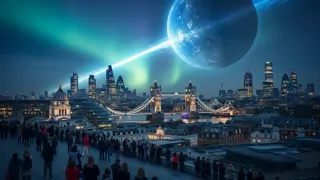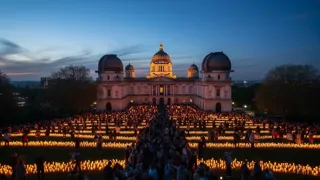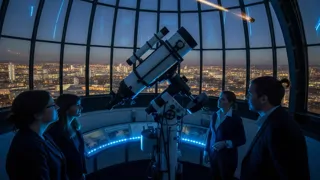Introduction
Above London, the night stretched infinitely—a sold-out show of constellations, satellites, and the slow, patient gaze of the Greenwich Observatory. The old brick buildings, cheek-by-jowl with the River Thames, glimmered under sodium lamps, outshone only by the distant, fierce clarity of stars. For centuries, these domes had cradled eyes and lenses eager to chart the universe's story. The air tonight was charged with an expectant hush, as though the city itself held its breath, eavesdropping on cosmic whispers. Dr. Lydia Morgan, chief astronomer, stood by the modern refractor, heart tuned to the sky’s every quiver, her mind dancing through data. Across the glowing monitors and squeak of computer keys, her team sifted statistics, cross-checked odd signatures, and chased the lingering hope that the universe held one more secret for them. Meanwhile, the world beyond continued its usual chaos of traffic, laughter, and late-night buses, oblivious to the fact that perhaps, in the data sweeping across Lydia’s trembling fingertips, hung the fate of everything they’d ever known.
The Discovery: Shadows on the World
For Dr. Lydia Morgan, routine had been a comfort—a methodical balm against the unpredictable tides of fate. Each night, Greenwich’s observatory domes welcomed her like old friends. On this particular evening, however, the familiar rhythms faltered. The robotic telescope, working in concert with national and amateur networks, caught something odd: a faint, cold band, moving rapidly against the static tapestry of familiar stars.

She called her closest colleague, Arun Patel, a keen-eyed astrophysicist who preferred nights to days and silence to conversation. Together they watched. The object, at first, seemed a mere data glitch—those happened often enough to breed skepticism. But this ‘glitch’ refused to behave. Files jammed with unfiltered starlight showed a second trail: unmistakable, undeniable. It was not a comet, nor the echo of an asteroid’s path, nor a satellite on low orbit. The mathematical analysis—distilled through sleepless hours—pointed to only one conclusion: a rogue planet, expelled from elsewhere, cut loose in the galactic dark.
Lydia’s hands trembled as she drafted the preliminary report. “If this holds,” she whispered, “we’re standing at the edge of something no one’s seen before.” Arun only nodded, but his gaze, usually placid, shone with fear. Both understood. The odds of such an event were astronomical—less likely than winning the lottery a thousand times over. And yet, here it was—their burden and their secret. The days rushed by in a blur of calculations, error-checking, and tense phone calls with other observatories. Eventually, the evidence became irrefutable: the planet’s trajectory taped an ominous arc—not just toward the Sun, but toward Earth itself.
News, always hungry, found its scent. Leak followed whisper; CNN anchors recited numbers neither they nor their viewers could easily parse. #TheStar trended by dawn, soon splitting into camps of deniers, doomsayers, jokers. In the observatory, the mood thickened—heavy with the terror of the unknown.
The planet was dubbed "The Star" by a viral social media meme, more in irony than astronomy. Headlines screamed: END TIMES or MIRACLE or just NASA HIDING SOMETHING. Politicians scrambled; Cambridge and Oxford offered think tanks; the government convened emergency sessions. But in the end, math was cold, clear, and merciless. Barring a cosmic fluke, The Star would pass close enough to trigger unpredictable devastation.
Lydia’s small team—her assistant Melanie, Arun, the night janitor Tom (who’d become a stubborn, steady presence), and visiting researcher Professor Cao from Shanghai—worked through sixteen-hour shifts. Obscure details began to matter—tiny gravitational fluctuations, the rogue’s chemical fingerprint. Journalists and neighbors stationed outside the iron gates demanded reassurance or prophecy. Lydia grew gaunt, her gaze always drifting back to the charts. "They’re looking for comfort," she muttered one evening, "but what happens when even the stars can’t comfort us?"
In Parliament, plans were made: evacuation models, survival contingencies, speeches. Yet across the globe, attitudes varied—panic in some streets, fatalistic parties on others, and quiet vigils in village churches. Lydia’s team realized they were living the strange paradox of all scientists: knowing more, but able to do less. Their hope lay in understanding—if nothing else, they’d record every second, chart every deviation, hoping their knowledge might help future generations sift meaning from catastrophe.
Countdown and Consequence
Weeks blurred together as spring quickened, petals brightening the parks and riverbanks, a taunting contrast to the looming shadow in the heavens. The Star’s approach was relentless. Old science fiction films found new popularity; the world obsessed over evacuation strategies, but the truth was stark—the event horizon came too soon for civilization to prepare.

The government declared a national week of reflection: schools closed, offices shuttered, and shops sold out of candles and bottled water. Lydia’s team became minor celebrities—interviews, news panels, a documentary crew trailing them through the halls, even as none of them could supply real comfort. Lydia took to drifting, sleepless, among the telescope domes, the Thames rolling calmly beneath the night fog. Her thoughts circled the inevitable: could her data help mitigate the disaster, perhaps buy the world a few precious days, or would it just be a record for posterity?
As the Star drew closer, it became visible to the naked eye—first as a bluish flicker, steadily swelling night after night. Urban crowds gathered atop bridges; churches filled for impromptu services. Some raged; others celebrated. Art blossomed—murals, flash mobs, orchestras on the street corners—transforming London into a city of both mourning and hope.
Arun worked frantically to develop a new modeling algorithm, hoping to predict whether the rogue planet would spark an extinction-level event, or if Earth might survive with catastrophic but limited loss. Melanie became the team’s gentle center, organizing support for panicked schoolchildren, writing blogs and answering thousands of desperate emails. Professor Cao, meanwhile, found solace in translating ancient Chinese texts describing “guest stars”—an echo from history, from a time when unknown lights inspired not dread, but awe.
Inside Parliament, politics turned brutal—plans for elite shelters and international evacuations. Lydia watched, dismayed at the selfishness, but also inspired by unheralded heroics: nurses and teachers who refused to leave their posts, engineers maintaining power and water, strangers sharing food with neighbors. Humanity had so rarely faced an enemy so untouchable. Panic sometimes blossomed into violence, but it also birthed unity, as if standing side by side, watching the inexorable approach, allowed people to become a single, beating heart beneath the indifferent stars.
On the night The Star reached its closest passage, the observatory hosted a vigil. Crowds spilled across Greenwich Park, a sea of faces streaked with tears, laughter, resolve. Lydia, gaunt and sleepless, clutched the hand of an old rival turned friend, staring straight at the phenomenon she had always dreamed of seeing. Streetlamps dimmed as the city surrendered to darkness, and then—
A surge of blue-white fire washed across the sky. For a moment, night became day. The rogue planet snarled with auroras and trailing debris, its passage a thundering, incomprehensible marvel. Buildings trembled; alarms wailed from Canary Wharf to Croydon; yet for most, there was nothing to do but watch, breathless.
Then, as the Star wheeled past, the world exhaled. Windows rattled, tidal surges battered the shore, and London’s heart skipped—but the planet did not strike. The world survived, battered but alive. Lydia collapsed to her knees. Around her, people sobbed, laughed, and whispered—some prayed; some simply marvelled at what the universe had spared.
Aftermath: The New Astronomy of Hope
The weeks after the passing brought a world forever changed, though not fractured. Earth had survived, and humanity—through grit, compassion, and a stubborn urge to make meaning—began to heal. The Star left scars and wonders: tides reworked, strange lights in the northern sky, meteorite fragments scattered across fields and lakes. Yet somehow, most cities, including London, stood proud if weathered, testament to both luck and quiet resilience.

The Greenwich team became honored not for foretelling doom, but for helping society meet the unknown with courage and clarity. Lydia, at first, struggled beneath the weight of survivor’s guilt. Her nights brimmed with dreams of what might have been. Arun’s new equation—improved through marathon sessions with colleagues in Berlin and Cape Town—uncovered more subtleties in celestial mechanics, giving humanity better tools for what might come next. Melanie set up Uplink, a network connecting schoolchildren worldwide to share their experiences through art and stories, making the cosmos less frightening by weaving it into their culture of hope.
Professor Cao’s translations blossomed into a global project: stories from every era where humanity had faced the sky’s mysteries with wonder. Poetry readings were held under rebuilt observatory domes. The atmosphere remained bruised but grew clearer by the week. The climate, so delicately balanced, adapted to new rhythms; the tides, seasonally tumultuous, bred both challenge and opportunity.
It was in this world that Lydia found new purpose. She spearheaded an international program for near-Earth object detection, sharing British expertise with countries across every continent. Disaster had fostered a unity unthinkable mere months before—the era of secrecy gone, replaced by collaboration.
London, with its patchwork of old and new, symbolized humanity’s bruised optimism. Vigils continued, but so did concerts, festivals, and creative explosions. The city’s artists painted new murals—meteors “falling” into the Thames, celestial dancers weaving above Parliament. Science, art, and hope colluded to transform fear into wonder. Children pointed skyward, not with dread, but with curiosity.
A year to the day after The Star’s passing, Lydia returned to the hill below the Observatory, now a popular gathering place. Candles flickered as music soared. She thought of the millions who had stood in awe, the courage found in facing the end, and the gift of another sunrise. The stars above shone as they always had—unmoved, but somehow, forever altered by what hearts on Earth had learned.
Conclusion
Some say the universe is indifferent, that stars and planets spin blind to our fears and longing. Maybe that’s true. But when the unknown burned blue in the night above London—when hope seemed extinguished and nothing felt certain—it was human hearts, gathered in frightened unity, that refused to surrender. Dr. Lydia Morgan and her team reminded the world that knowledge is an act of courage, that recording truth with trembling hands may sometimes be our greatest gift. Disaster revealed not just the vulnerabilities of flesh and stone, but the spine of a people who, faced with oblivion, chose to comfort each other, build again, and look up—undaunted—at the sky. Even when the universe threatened to close its book on our story, humanity wrote another page. And as new generations point telescopes at the heavens, they’ll remember not only what was nearly lost, but all that was found when the world stared, together, into the face of The Star.

















